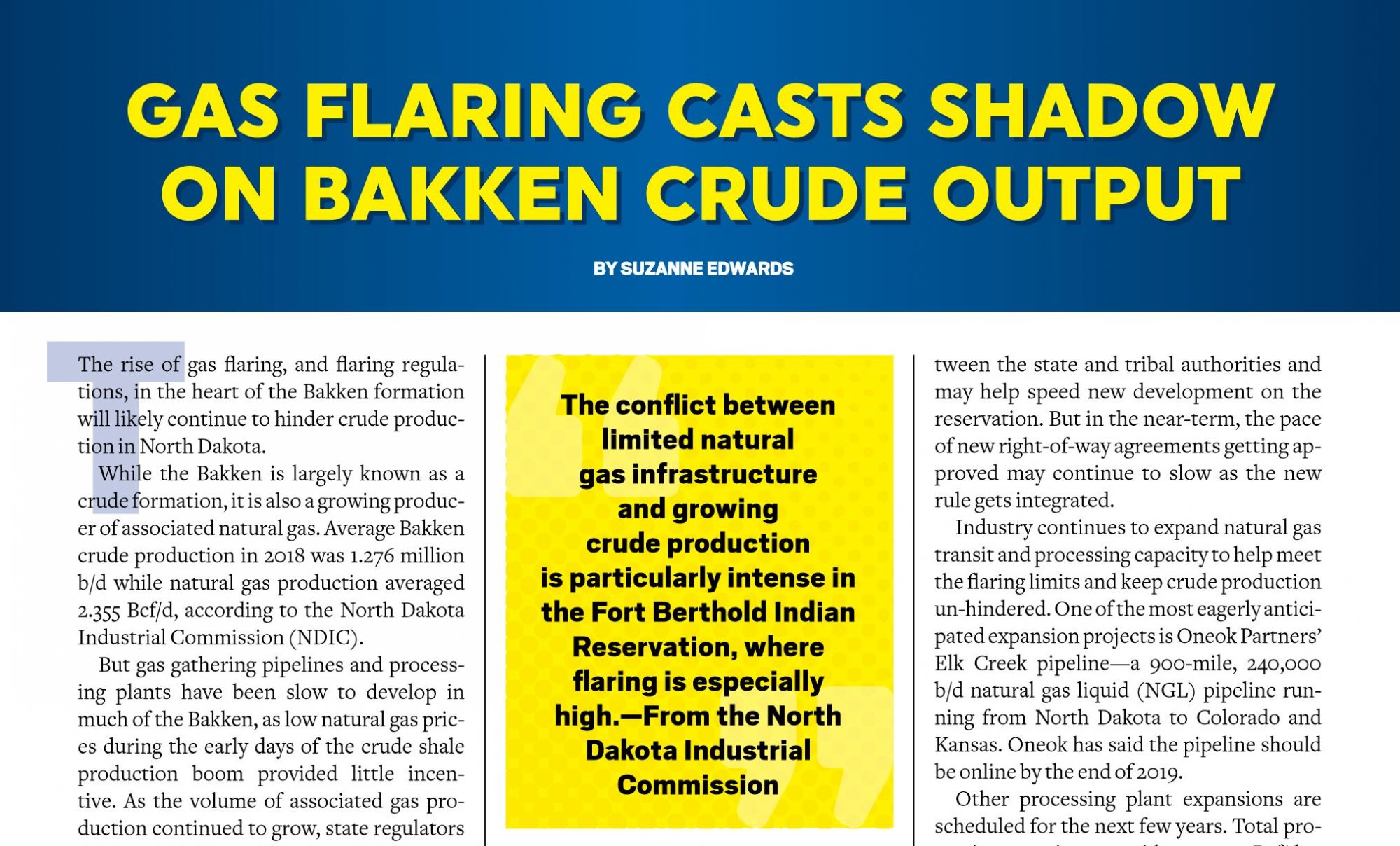Gas Flaring Casts Shadow on Bakken Crude Output
BY Suzanne Edwards

The rise of gas flaring, and flaring regulations, in the heart of the Bakken formation will likely continue to hinder crude production in North Dakota.
While the Bakken is largely known as a crude formation, it is also a growing producer of associated natural gas. Average Bakken crude production in 2018 was 1.276 million b/d while natural gas production averaged 2.355 Bcf/d, according to the North Dakota Industrial Commission (NDIC).
But gas gathering pipelines and processing plants have been slow to develop in much of the Bakken, as low natural gas prices during the early days of the crude shale production boom provided little incentive. As the volume of associated gas production continued to grow, state regulators stepped in and created a system of steadily increasing limits on the amount of natural gas that can be flared. The state can now force producers to cut output if they do not meet their gas capture targets.
In November last year, North Dakota’s state-set gas capture target increased from 85 to 88 percent, leading producers to self-restrict oil output by an average of 99,000 b/d that month, according to the oil and gas division of the NDIC. That was the first time officials reported such curtailments in response to flaring mitigation efforts.
Even with the voluntary curtailments in November, gas capture was 79 percent that month, the worst state-wide capture performance of 2018.
Severe winter cold and maintenance at the Hess-Tioga gas processing plant near North Dakota’s border with Canada also dampened crude output that month. Even as the plant came back online for December, gas capture only improved by 2 percentage points to 81 percent.
Gas capture rates for the state have held at that 81 percent in the first two months of 2019, despite a retreat in crude production stemming from winter weather. This means more self-imposed curtailments in crude output are likely to continue going forward, even as infrastructure expansion projects are underway.
The conflict between limited natural gas infrastructure and growing crude production is particularly intense in the Fort Berthold Indian Reservation, where flaring is especially high, the NDIC has said.
The Reservation’s underlying geology is prolific, but setting up sufficient infrastructure to capture the associated gas produced on the land is even more difficult than in other parts of the state. Right-of-way agreements needed to build natural gas pipelines that connect with interstate lines, or processing plants, are under the purview of both the Bureau of Indian Affairs and authorities of the Three Affiliated Tribes, also known as the MHA Nation—a double-layer of bureaucracy that has slowed new pipeline projects. Drilling permits, on the other hand, have not significantly slowed, indicating a rise in production alongside a stalling of infrastructure expansion.
Hence, Fort Berthold production accounts for a larger share of statewide gas flaring.
A new law, signed by North Dakota’s Governor at the end of March, is designed to alter the tax-sharing arrangement between the state and tribal authorities and may help speed new development on the reservation. But in the near-term, the pace of new right-of-way agreements getting approved may continue to slow as the new rule gets integrated.
Industry continues to expand natural gas transit and processing capacity to help meet the flaring limits and keep crude production un-hindered. One of the most eagerly anticipated expansion projects is Oneok Partners’ Elk Creek pipeline—a 900-mile, 240,000 b/d natural gas liquid (NGL) pipeline running from North Dakota to Colorado and Kansas. Oneok has said the pipeline should be online by the end of 2019.
Other processing plant expansions are scheduled for the next few years. Total processing capacity statewide was 2.44 Bcf/d at the end of 2018, and should rise to 3.14 Bcf/d by the end of 2019. By 2021, processing capacity should rise again to total 3.38 Bcf/d, according to the North Dakota Pipeline Authority (NDPA).
The benefit of the added capacity will be short-lived. The planned plant expansions are located in the traditional core production area of the Bakken, centered on the intersection of Mountrail, McLean, McKenzie and Dunn counties. Output growth is moving outside that area.
In addition to the geographical mismatch, the NDPA estimates that natural gas production will outpace processing capacity by 2021 or 2023 depending on different crude-price scenarios.

Suzanne Edwards
Suzanne Edwards is the natural gas reporter at Argus Media, Houston. She presented the webinar The Bakken bottleneck: Will the rise of flaring kill the boom?, which you can access here. For more information, visit www.argusmedia.com.
